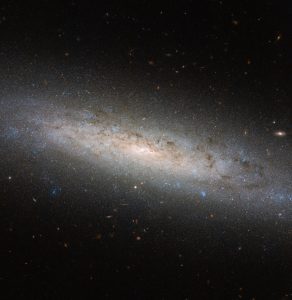Il Lato Oscuro di NGC 24
Questo disco luminoso e scintillante di galassia a spirale si trova a circa 25 milioni di anni luce dalla Terra nella costellazione dello Scultore. Chiamata NGC 24, la galassia è stata scoperta dall’astronomo William Herschel nel 1785, e si estende per circa 40.000 anni luce.
L’immagine, ripresa dall’Advanced Camera for Surveys a bordo del telescopio Hubble mostra NGC 24 in grande dettaglio, mettendo in evidenza le giovani stelle blu appena formate, le fasce oscure di polvere cosmica, e gli addensamenti rossastri di idrogeno gassoso, materiale sparso attraverso i bracci di spirale della galassia. È possibile osservare numerose galassie distanti attorno al perimetro di NGC 24.
Tuttavia, in questa placida immagine è nascosto un lato oscuro, più di quanto sia possibile vedere. Gli astronomi ritengono che galassie a spirale come questa e la Via Lattea siano contenute in e circondate da aloni estesi di materia oscura. La materia oscura non può essere osservata, ma si rivela attraverso le interazioni gravitazionali che esercita sul materiale circostante. Si pensa che svolga un ruolo essenziale nella formazione ed evoluzione delle galassie. La maggior parte della massa di NGC 24, ben l’80 percento, è probabilmente compresa all’interno di un simile alone di materia oscura.
[ Barbara Bubbi ]
http://www.spacetelescope.org/images/potw1639a/
Credit:ESA/Hubble & NASA

Lascia un commento